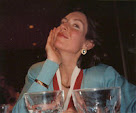The third vignette in a "natural holiday decorating" group I created recently for the Boston Globe g Magazine, was a woodland setting, which is absolutely one of my favorite subjects to play with. There is something about all of nature, but especially woodsy materials, that I just adore. Mosses, twigs and pinecones remind me of glorious walks through forested areas, under canopies of leafy trees, where the mysteries of animal and plant life are all-surrounding and quietly poignant.
When I was little, and then again when my children were little, imagining and building fairy huts and villages was a favorite activity. My kids even wove together little sticks to create fences to encircle fairy homes. I remember the joy in their voices as they would run into the house calling for us to come outside and see what they had built for the fairies in our gardens.
In my decorating, I also love bringing woodsy materials into the house, connecting the outdoor world with the one indoors. A couple of summers ago, I wrote a blog post on one of my favorite table settings of all time, which I did using various mosses as a way to frame my Herend Rothschild Bird china.

 For the Globe article, I wanted to incorporate three of my paintings of songbirds in topiaries, which I hung over our dining room sideboard. Additionally, I used some wonderful Italian ceramic pieces designed by The Mane Lion - a footed serving bowl and a pair of candlesticks, all with pheasants on them - and other birds, including cement garden ornaments and several Herend china pieces from Hungary.
For the Globe article, I wanted to incorporate three of my paintings of songbirds in topiaries, which I hung over our dining room sideboard. Additionally, I used some wonderful Italian ceramic pieces designed by The Mane Lion - a footed serving bowl and a pair of candlesticks, all with pheasants on them - and other birds, including cement garden ornaments and several Herend china pieces from Hungary. Jaci Conry, who wrote the Globe article, had asked me specifically to incorporate a fruit topiary into the setting, so I decided to make two, since the sideboard in my dining room is formal and some symmetry seemed appropriate. I used two planters I had with rustic birds and vines on them, but instead of making tall topiaries, I kept them low, using dry floral foam cut into dome shapes. I then skewered kumquats on toothpicks and stuck them into the foam, varying the heights as necessary to create nicely rounded domes.

Next, I tucked bits of moss into the holes between the fruits and finally gave the topiaries some interesting color and height variation with small sticks of bittersweet berries, gathered near my home.
The vibrant kumquats and bittersweet complement the oranges and reds in my paintings.
I have always loved birch trees, logs and bark - probably a throwback to my childhood in Minnesota, where we camped in the woods "up North" every summer. I wanted to use birch logs in this setting, so my husband, Jack, made me some great candle holders by cutting logs to varying sizes (3" to 8" high) and hollowing out the tops to create cavities for votive candles.

Using a hot glue gun, I attached different colors and textures of moss to the tops of the candle holders, allowing some of them to drape down over the sides for a more natural look.
Mosses included a number from my own yard, plus some I had purchased at Michael's Crafts. The bluish green moss, above, grows naturally on trees all over Cape Cod, and I have a plentiful supply in my yard.
Before lighting the votive candles, I spray the moss with water, to prevent it from catching on fire. (Of course, one should never leave burning candles unattended in any case!)

I cut lots of greens - holly, arborvitae, cedar, spruce, laurel, etc. - to tuck into the pheasant centerpiece. Here again, I used floral foam, but this time I soaked it with water ahead of time so the greens would stay fresh and alive for a week or more. On the top of the sideboard, I had such fun arranging various greens, birds, pinecones, leaves, mosses, sticks and walnuts.
Finally, I topped off the whole scene with more arborvitae, tucked in above and behind the paintings.
What could be more perfect with this dining room setting than a French buche de Noel cake for dessert? That's what I'll do next year!








































